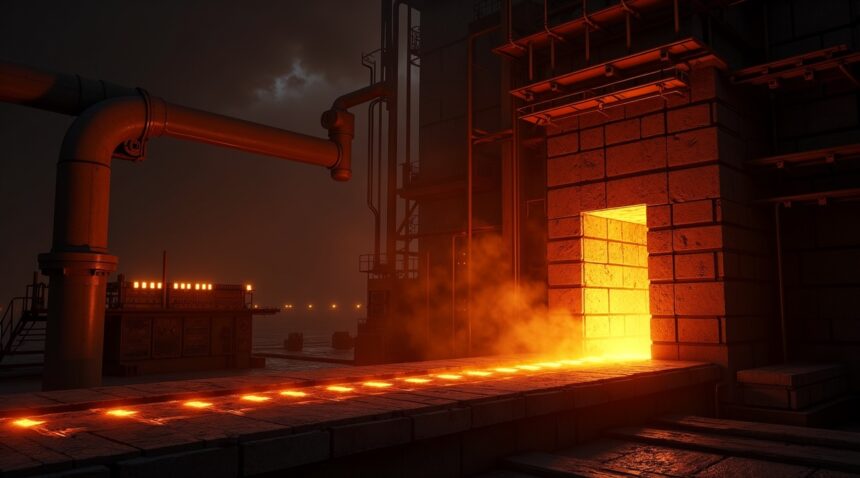NASA’s Curiosity rover has uncovered a game-changing mineral on Mars: tridymite, known for defying traditional heat conduction principles by maintaining consistent thermal conductivity across extreme temperatures from 80 K to 380 K.
Key Takeaways
- Tridymite maintains thermal consistency across a 300-degree temperature range, a feat that contradicts conventional physics where materials usually lose thermal efficiency as temperature increases.
- Steel manufacturing could benefit greatly from tridymite’s resilience, helping reduce carbon emissions and lowering costs by extending the life of furnace components.
- Its hybrid crystal-glass structure makes tridymite applicable in diverse fields such as electronics, aerospace, and high-tech manufacturing.
- Unexpected deposits on Mars suggest the Red Planet’s volcanic history is far more complex than previously thought, challenging current geological models.
- Machine learning is expediting synthetic production, allowing researchers to explore combinations rapidly and bring tridymite’s applications closer to reality.
Revolutionizing Thermal Conductivity
Tridymite poses a direct challenge to foundational assumptions in materials science. Traditionally, materials exhibit declining thermal conductivity at high temperatures, following well-established physical laws. However, tridymite does not adhere to this behavior.
Tests indicate the mineral remains stable from cryogenic temperatures to levels that liquefy most metals. This remarkable consistency opens revolutionary possibilities across sectors where precise thermal management is vital.
Steel Industry: The Immediate Beneficiary
The steel manufacturing industry, responsible for approximately 7% of U.S. carbon emissions, stands to gain significantly from tridymite. Refractory materials in blast furnaces degrade quickly during repeated heat cycles, necessitating frequent and costly replacements. The integration of tridymite could extend the lifespan of furnace linings from months to years, optimizing both operational costs and energy usage.
Understanding Tridymite’s Structure
Tridymite’s capabilities stem from its unique composition. Unlike standard crystalline or amorphous materials, it blends ordered and disordered atomic structures into a hybrid form. This duality permits stable heat flow regardless of rising or falling temperatures, a phenomenon unseen in conventional materials.
Electronics and Aerospace Integration
In the tech world, overheating continuously limits processor performance and lifespan. Tridymite holds the potential to dissipate heat more predictably, especially in compact electronics like smartphones and laptops. Improved cooling could allow for faster processing speeds and increased reliability.
In aerospace, where spacecraft endure temperatures ranging from intense heat during atmospheric entry to extreme cold in deep space, tridymite could replace heavy thermal insulation systems. Its lightweight, stable properties would simplify engineering and reduce launch mass.
Geological Implications of Martian Tridymite
The mineral’s presence on Mars is as puzzling as its properties. According to current models, the planet lacked the extreme volcanic conditions needed to form tridymite. Its substantial deposits force scientists to reevaluate assumptions about ancient Martian volcanic activity.
Challenges in Synthesizing Tridymite
Sourcing natural tridymite from Mars is impractical, prompting urgent research into synthetic alternatives. Machine learning plays a pivotal role in simulating and testing potential combinations and lab conditions to replicate its properties on Earth. By analyzing billions of data points, algorithms help accelerate discovery, reducing the development cycle from decades to just years.
Although early synthetic trials are encouraging, they haven’t yet matched Martian tridymite’s complete thermal resilience. Researchers continue experimenting with structure and temperature to perfect replication techniques.
Broad Industrial Applications
- Renewable energy systems—solar panels often lose efficiency during high heat. Tridymite could stabilize their output across daily temperature swings.
- Nuclear reactor safety—its durability at high temperatures positions tridymite as a promising material for next-generation containment systems.
- Electric vehicle batteries—tridymite could prevent energy losses caused by overheating, particularly in extreme climates, extending battery lifespan and performance.
Widespread Collaboration and Impact
Government labs, universities, and private enterprises are forming international coalitions to unlock tridymite’s full potential. Open data sharing and cross-border investment draw from the best global minds in material science, exponentially speeding up breakthroughs.
Economic and Environmental Impacts
Wide adoption of synthetic tridymite implies remarkable savings. In industries reliant on thermal efficiency, such as steel and power generation, cost reductions and decreased environmental footprints are expected. Less frequent replacement of components also curbs waste and reduces the environmental impact of raw material extraction.
Patent and Investment Trends
Patent activity surrounding tridymite applications has surged. Companies are racing to protect their innovations and secure early market opportunities. Simultaneously, venture capital firms and national science agencies are boosting funding support, enhancing the feasibility of scalable synthetic manufacturing.
The Road to Commercialization
- Process adjustments—current factories will need to modify equipment to support tridymite integration effectively.
- Quality control enhancements—new testing methodologies will be required to measure the hybrid structure and thermal accuracy of synthetic variants.
- Cost-efficiency—despite its potential, widespread use will only become viable with affordable synthetic replication solutions.
Global Cooperation on the Horizon
As research progresses, international partnerships could play a key role in cost-sharing and knowledge exchange. Nations with strong material science backgrounds may combine efforts to conquer the technical hurdles facing this marvel of thermal conductivity.
Looking Ahead
Future Mars missions, including sample return strategies and geological mapping, aim to provide critical insights into tridymite’s natural formation processes. This data may ultimately help scientists recreate the exact environmental conditions required to synthesize the mineral on Earth.
The discovery of tridymite once again illustrates how space exploration delivers unexpected but immensely valuable contributions back to technology on Earth. By looking beyond our planet, we often find the keys to solving our most pressing industrial and environmental challenges.
Revolutionary Heat Management Breakthrough From Space
I’ve witnessed countless scientific discoveries, but tridymite’s emergence from Mars represents something truly extraordinary in thermal management. This crystalline form of silica maintains steady thermal conductivity across an impressive temperature range, from 80 K to 380 K, completely defying conventional heat conduction rules that scientists have relied on for decades.
Traditional thermal transport models predict that materials should exhibit varying conductivity as temperatures change dramatically. Tridymite throws this expectation out the window. Its consistent thermal properties across such a wide temperature spectrum challenge everything I thought I knew about heat management, opening doors to applications that seemed impossible just years ago.
Industrial Applications That Could Transform Manufacturing
The steel industry stands to benefit enormously from tridymite’s unique characteristics. Current refractory bricks in steel furnaces struggle with temperature fluctuations, leading to frequent replacements and inefficient heat management. Incorporating tridymite or similar hybrid materials into these bricks could extend their lifespan significantly while optimizing heat control throughout the production process.
Consider these potential improvements for steel manufacturing:
- Extended refractory brick durability reducing maintenance costs and downtime
- Consistent heat distribution preventing hot spots and thermal stress
- Enhanced energy efficiency through predictable thermal conductivity
- Reduced material waste from premature brick failure
Steel production currently contributes nearly 1.3 kg CO2 per kilogram of steel produced, accounting for around 7% of the U.S.’s total carbon emissions. The environmental implications of improved thermal management extend far beyond simple efficiency gains. Better heat control means less energy waste, fewer carbon emissions, and more sustainable manufacturing processes.
I find it fascinating how a mineral discovered through lunar exploration missions could revolutionize terrestrial manufacturing. Tridymite’s heat-defying properties represent more than just an interesting scientific anomaly; they offer practical solutions to some of industry’s most persistent thermal management challenges.
The potential applications extend beyond steel production into any industry requiring precise temperature control. Electronics manufacturing, aerospace engineering, and energy production could all benefit from materials that maintain consistent thermal properties across wide temperature ranges. Imagine computer processors that maintain optimal operating temperatures regardless of workload, or spacecraft components that handle the extreme temperature variations of space travel without compromising performance.
Research teams are already exploring synthetic production methods for tridymite-like materials. Creating these substances in controlled laboratory environments could make them more accessible for industrial applications while maintaining their remarkable thermal properties. The challenge lies in replicating the specific conditions that create tridymite’s unique crystalline structure.
Manufacturing industries face increasing pressure to reduce their environmental impact while maintaining production efficiency. Tridymite offers a path forward that addresses both concerns simultaneously. Its consistent thermal conductivity could enable more precise process controls, reducing energy waste and improving product quality.
The steel industry’s carbon footprint represents a significant environmental challenge that requires innovative solutions. Traditional approaches to reducing emissions often involve trade-offs between environmental benefits and production efficiency. Tridymite’s properties suggest that such compromises might not be necessary. Better heat management could deliver both environmental and economic benefits.
I believe this discovery represents just the beginning of a new era in thermal management technology. As researchers continue studying tridymite’s properties and developing synthetic alternatives, we’ll likely see applications emerge in fields we haven’t even considered yet. The material’s ability to maintain consistent thermal conductivity across such a wide temperature range opens possibilities for innovations in everything from renewable energy systems to advanced manufacturing processes.
Curiosity Rover’s Unexpected Discovery in Martian Rocks
NASA’s Curiosity rover stumbled upon a geological puzzle that’s forcing scientists to rethink what they know about Mars. While exploring Gale Crater, the rover collected a mudstone sample that revealed something extraordinary: approximately 14 weight percent of tridymite, a mineral that shouldn’t exist in this context according to conventional geological understanding.
A Mineral Out of Place
The sample’s composition reads like a geological anomaly. Beyond the surprising tridymite content, the mudstone contained approximately 17 weight percent plagioclase, along with sanidine, cristobalite, and anhydrite. What makes this discovery even more remarkable is the sample’s overall composition—the total crystalline content reached approximately 40%, while silica (SiO₂) levels soared to an unusually high 74 weight percent.
These numbers tell a story that doesn’t align with current models of Martian geology. Tridymite typically forms under low-pressure, high-temperature conditions exceeding 870°C, making it a common resident in Earth’s silicic volcanic rocks. However, finding this heat-loving mineral embedded in sedimentary mudstone on Mars creates a scientific contradiction that demands explanation.
Implications for Martian Geological History
This discovery forces a complete reevaluation of Mars’s volcanic past. The presence of tridymite in sedimentary rock suggests that Mars experienced far more complex silicic volcanism than previously understood. Such volcanism requires specific conditions—high temperatures and particular chemical environments—that weren’t thought to be prevalent on the Red Planet.
The implications extend beyond simple volcanic activity. The mineral’s presence in this sedimentary context hints at intricate water-rock interactions that occurred over extended periods. Water must have played a crucial role in transporting and depositing these crystalline materials, creating geological processes that mirror some of Earth’s most complex formations.
Scientists now face the challenge of reconciling this evidence with established theories about Martian evolution. The discovery suggests that early Mars possessed a more dynamic and Earth-like geological system than previously imagined. This complexity could have profound implications for understanding the planet’s potential to harbor life, as such diverse geological processes often create the chemical conditions necessary for biological activity.
The Curiosity rover’s find also raises questions about how common such unexpected mineral formations might be across Mars. If tridymite exists in Gale Crater’s sedimentary layers, similar formations could be scattered throughout the planet’s geological record, waiting to rewrite our understanding of Martian history.
This discovery connects to broader space exploration efforts, including recent developments in NASA’s slingshot project and findings from other missions that continue to reveal the solar system’s complexity. Each new discovery builds upon previous knowledge, creating a more complete picture of planetary formation and evolution.
The tridymite discovery represents more than just an interesting geological curiosity. It’s a reminder that Mars continues to surprise researchers with its complexity, challenging assumptions and opening new avenues for understanding planetary processes. As future missions prepare to explore Mars in even greater detail, this unexpected mineral serves as a testament to the planet’s ability to defy expectations and reveal new secrets about its ancient past.
Unique Crystal Structure Defies Physics Rules
Tridymite’s remarkable crystal structure challenges conventional understanding of how materials behave under extreme heat. This extraordinary mineral exists in seven distinct crystalline forms, with monoclinic, orthorhombic, and hexagonal structures being the most significant. Each form maintains stability within specific temperature ranges, though β-tridymite demonstrates particular resilience by remaining stable above 870 °C.
The internal architecture of tridymite occupies a fascinating middle ground between perfectly ordered crystals and completely disordered glass. This unique positioning creates thermal behaviors that researchers haven’t observed in other SiO₂ polymorphs, making it a standout among silicon dioxide variants. The structure’s ability to maintain partial order while exhibiting some randomness gives it properties that could revolutionize how we approach high-temperature applications.
Thermal Conductivity That Breaks the Rules
Unlike conventional ceramic materials that lose thermal conductivity as temperatures rise, tridymite maintains consistent conductivity across varying temperature ranges. This behavior directly contradicts established physics principles that govern most materials. Traditional ceramics follow predictable patterns where increasing heat reduces their ability to conduct thermal energy efficiently.
Formation patterns on Earth reveal another layer of tridymite’s unusual nature. The mineral rarely forms directly from quartz without the presence of additives such as alkali metals. Instead, quartz typically transforms into cristobalite around 1050 °C, bypassing tridymite formation entirely. This preference suggests that essential building blocks for tridymite require specific conditions that don’t commonly occur in terrestrial environments.
Mars presents a different story entirely. The planet’s unique geological conditions and atmospheric composition appear to favor tridymite formation over other SiO₂ polymorphs. Recent discoveries have shown significant tridymite deposits in Martian soil samples, indicating that the Red Planet’s environment provides ideal conditions for this remarkable mineral’s development.
The practical implications extend far beyond academic curiosity. Engineers and materials scientists recognize that tridymite’s heat-defying properties could transform energy efficiency applications. Industries requiring materials that maintain performance under extreme temperatures—from aerospace propulsion systems to advanced manufacturing processes—could benefit enormously from understanding and harnessing these unique characteristics. The mineral’s ability to maintain thermal conductivity while resisting conventional heat-related degradation positions it as a potential game-changer for next-generation thermal management systems.

Technology Applications Across Multiple Industries
The unique thermal properties discovered in Martian tridymite open pathways for transformative applications across numerous technological sectors. This silicon dioxide mineral’s ability to maintain structural integrity while exhibiting unusual heat flow characteristics positions it as a catalyst for innovation in energy-efficient technologies.
Revolutionary Heat Management Systems
Waste-heat recovery systems stand to benefit significantly from tridymite’s thermal management principles. Industrial facilities currently lose substantial energy through heat dissipation, but materials inspired by tridymite’s hybrid crystal-glass structure could capture and redirect this thermal energy more effectively. Power plants operating at higher efficiencies become possible when engineers apply these heat flow mechanisms to turbine designs and cooling systems.
Electronics miniaturization faces constant challenges with heat dissipation as components shrink while power demands increase. Tridymite’s thermal characteristics offer solutions for:
- Advanced thermal interface materials that conduct heat away from processors more efficiently
- Heat spreaders for high-performance computing systems requiring precise temperature control
- Thermal management substrates for 5G infrastructure and data centers
- Cooling solutions for electric vehicle battery systems and charging stations
The aerospace industry particularly benefits from materials that withstand extreme temperature variations while maintaining lightweight properties. NASA’s innovative projects demonstrate the ongoing need for advanced thermal management materials in space exploration missions.
Wearable energy devices represent another frontier where tridymite-inspired materials could excel. Smartwatches, fitness trackers, and medical monitoring devices require efficient heat dissipation in compact form factors. The mineral’s ability to manage thermal energy at the molecular level translates directly to longer battery life and improved device performance.
AI-focused computing platforms demand unprecedented thermal management capabilities as processing power continues expanding. Quantum computers, neural network processors, and machine learning accelerators generate significant heat loads that traditional cooling methods struggle to handle. Tridymite’s quantum-level heat transport mechanisms, involving electron and magnon behavior, provide blueprints for next-generation thermal solutions.
Smart grid technologies could incorporate tridymite-inspired materials to improve energy transmission efficiency. Power distribution systems lose energy through heat generation during electrical transmission, but advanced materials based on these thermal principles could reduce losses significantly. Solar panel efficiency improvements become possible through better thermal management, allowing photovoltaic cells to operate at optimal temperatures even under intense sunlight.
The automotive sector increasingly relies on efficient thermal management for electric vehicles and autonomous driving systems. Battery thermal management systems using tridymite-inspired materials could extend driving range while improving safety through better temperature control. Advanced driver assistance systems and LiDAR sensors require precise thermal regulation to maintain accuracy and reliability.
Renewable energy applications extend beyond solar panels to include wind turbine generators and geothermal systems. Wind turbines experience significant temperature variations, and materials that maintain performance across these ranges could improve energy output consistency. Geothermal energy extraction benefits from materials that efficiently transfer heat while resisting degradation from thermal cycling.
Manufacturing processes across industries could achieve greater efficiency through improved thermal management. Semiconductor fabrication, metal processing, and chemical production all involve precise temperature control where tridymite-inspired materials might reduce energy consumption while improving product quality.
Medical device applications present opportunities for thermal management in diagnostic equipment, therapeutic devices, and surgical instruments. MRI machines, CT scanners, and laser surgery systems require stable thermal environments for accurate operation. Implantable devices could benefit from materials that manage heat generation while maintaining biocompatibility.
The development of quantum sensors and precision measurement instruments could advance through better understanding of thermal noise reduction. Tridymite’s unique heat transport mechanisms may inspire materials that minimize thermal interference in sensitive measurement applications, enhancing accuracy in scientific research and industrial metrology.
Data storage technologies increasingly demand thermal stability as storage densities increase. Hard drives, solid-state drives, and emerging memory technologies generate heat that affects performance and longevity. Materials inspired by tridymite’s thermal properties could enable higher-capacity storage systems with improved reliability and reduced cooling requirements.

Steel Industry Carbon Emission Reduction Potential
The steel industry stands as one of the most energy-intensive sectors globally, contributing approximately 7% of carbon dioxide emissions in the United States. This massive environmental footprint stems largely from the extreme temperatures required for steel production and the frequent replacement of degraded furnace components. Traditional refractory bricks that line steel furnaces face constant thermal stress, causing them to deteriorate rapidly and requiring costly replacements that interrupt production cycles.
Enhanced Furnace Longevity Through Tridymite Integration
Materials enhanced with tridymite could dramatically extend the service life of these critical furnace components. Unlike conventional refractory materials that break down under extreme heat cycling, tridymite-enhanced bricks would maintain their structural integrity longer. This extended lifespan translates directly into:
- Reduced downtime for furnace maintenance
- Fewer material replacements
- Lower overall operational costs for steel manufacturers
Stable Thermal Performance Advantages
Conventional ceramics display a troubling characteristic where thermal conductivity decreases as temperatures rise, creating inconsistent heat distribution patterns within furnaces. Tridymite defies this limitation by exhibiting stable heat conduction across an extensive thermal range, tested from 80 K to 380 K. This consistent thermal behavior enables steel producers to maintain more precise temperature control throughout their processes.
The implications for emissions reduction are substantial. Better temperature control means:
- More efficient combustion
- Reduced energy waste
- Lower fuel consumption per ton of steel produced
Steel manufacturers could potentially reduce their carbon footprint while simultaneously improving product quality through more consistent heating patterns. These advances align with global climate mitigation efforts and demonstrate how materials discovered in space exploration can address terrestrial environmental challenges.
Industrial performance benefits extend beyond emissions reduction. Consistent thermal conductivity allows for more predictable furnace behavior, enabling operators to optimize their processes with greater confidence. This reliability could lead to:
- Improved steel quality
- Reduced waste from temperature variations
- Enhanced overall productivity in an industry where margins often depend on operational efficiency
Future Research and Martian Mysteries
The discovery of substantial tridymite deposits on Mars has opened fascinating avenues for planetary research that could reshape our understanding of the Red Planet’s history. These findings challenge previous assumptions about Martian geological processes and hint at a more complex volcanic past than scientists initially believed.
Mars’ tridymite deposits present a compelling puzzle because this mineral typically forms through silicic volcanic activity on Earth. This discovery suggests that Mars may have experienced sophisticated volcanic processes similar to those found on our planet, fundamentally altering theories about early Martian environments. Scientists are now investigating whether these formations indicate ancient magma chambers, explosive volcanic eruptions, or entirely different geological mechanisms unique to Mars.
Advanced Research Techniques Accelerating Discovery
Machine learning algorithms are revolutionizing how researchers study tridymite’s atomic-level properties, dramatically accelerating materials research timelines. These computational tools allow scientists to model complex molecular interactions without lengthy laboratory experiments, providing insights into how tridymite’s unique structure contributes to its exceptional thermal properties. I find this technological approach particularly promising because it bridges the gap between theoretical understanding and practical applications.
Future Mars missions will likely prioritize detailed analysis of tridymite-rich regions to uncover clues about the planet’s hydrologic and volcanic history. These investigations could reveal whether liquid water played a role in tridymite formation, potentially indicating habitable conditions in Mars’ ancient past. The implications extend beyond geology, as understanding these processes might illuminate how planetary systems evolve and maintain stable environments.
The research also holds significance for space exploration technology. Tridymite’s heat-resistant properties make it an attractive candidate for developing advanced materials for spacecraft and planetary habitats. Scientists are exploring whether synthetic versions could protect equipment during extreme temperature fluctuations encountered in space missions, similar to how NASA’s slingshot project pushes technological boundaries.
These Martian discoveries complement other recent findings, including essential building blocks for life found elsewhere in our solar system. Together, these revelations paint a picture of dynamic planetary processes that could have supported complex chemistry and potentially life itself.
Researchers anticipate that continued study of Martian tridymite will unlock secrets about planetary formation, volcanic evolution, and the conditions necessary for maintaining stable atmospheres. This knowledge could prove invaluable for future colonization efforts and our broader understanding of how planets develop and sustain environments capable of supporting life.

Sources:
Proceedings of the National Academy of Sciences, “Silicic volcanism on Mars evidenced by tridymite in high-SiO₂ sedimentary rock at Gale crater”
Energy Reporters, “Meteorite Silica Shocks Scientists as Research Reveals This Space Mineral Could Revolutionize How We Manage Heat in Factories and Power Plants”
Mindat.org, “Tridymite: Mineral information, data and localities”
YouTube: “Revolutionary Space Mineral: Tridymite’s Impact on Heat Management”
Wikipedia, “Tridymite”
Phys.org, “Hybrid crystal-glass materials from meteorites transform heat management”


